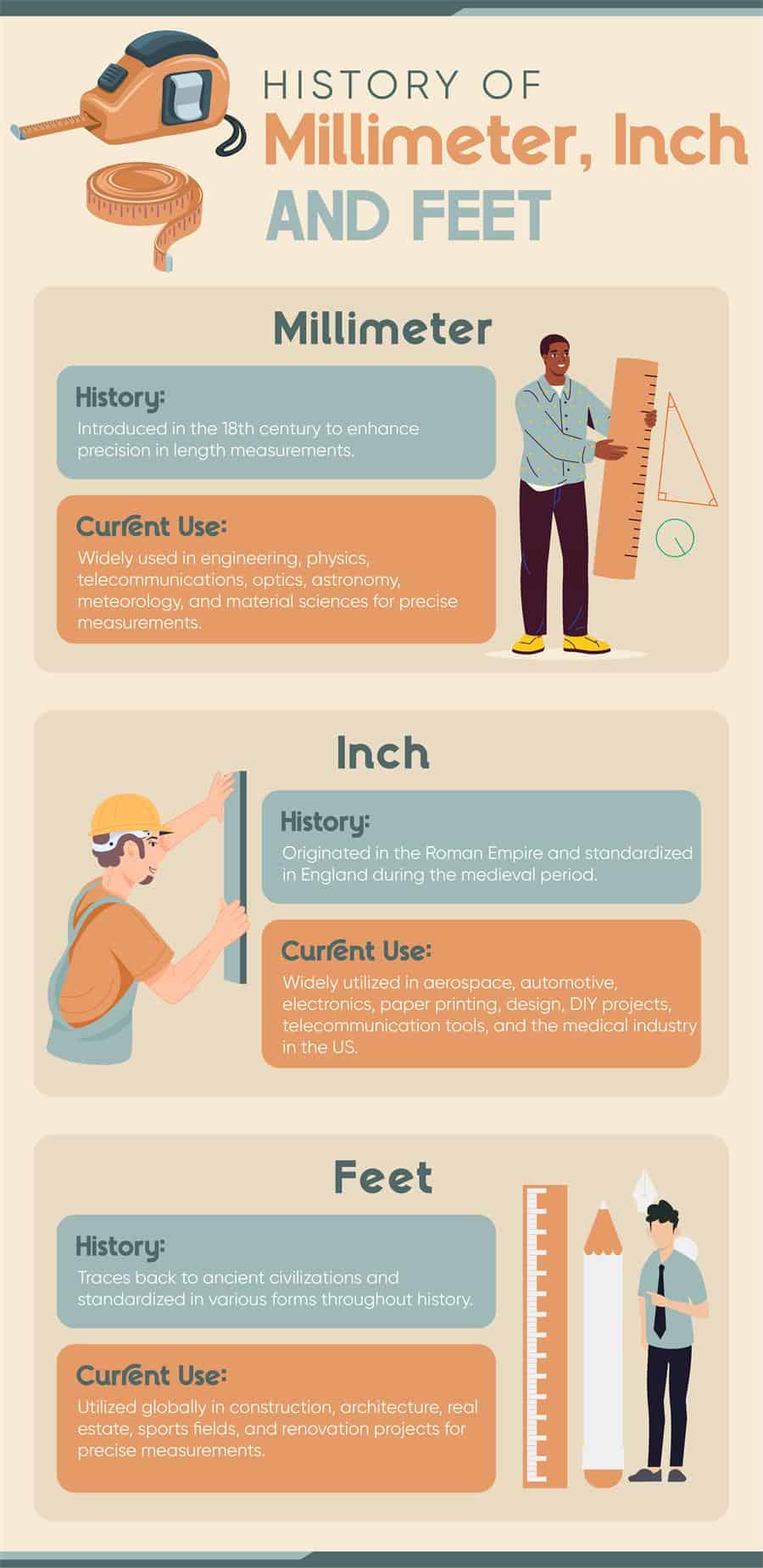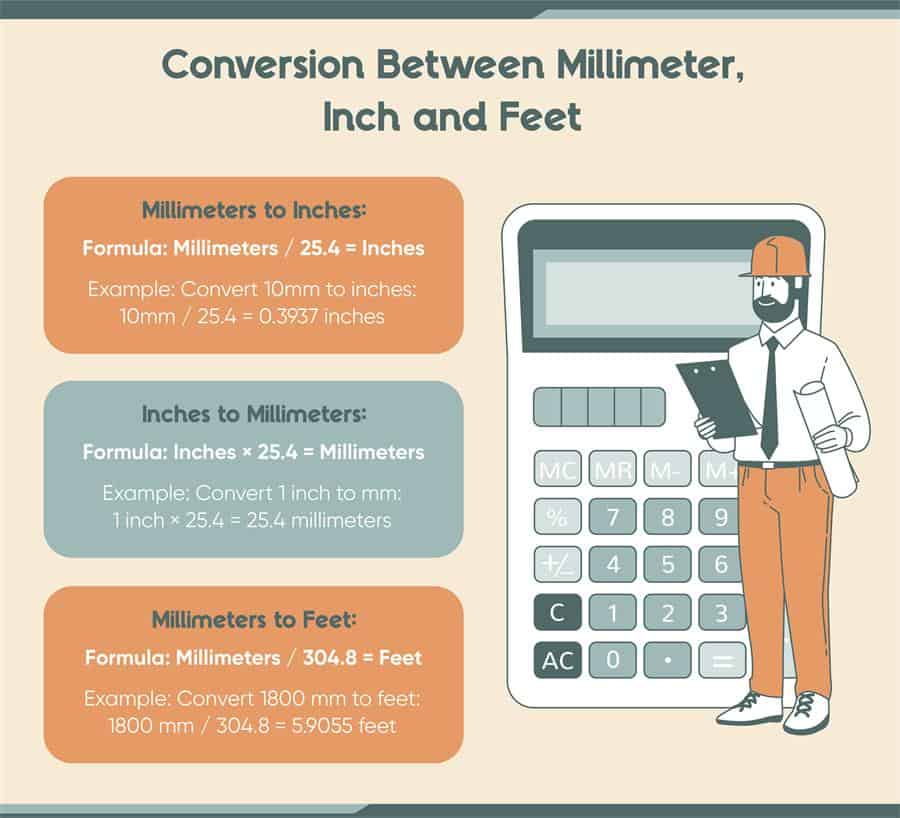Inch and mm convertor
MM and Inches Converter
MM and Feet Converter
The Comprehensive Guides to Convert Millimeter, Inch and Feet
Millimeters, inches, and feet are units that are used to measure the length of an object. Each of these units is useful to assess the material quantity for any area. Here is the comprehensive guide to understanding all these units and how you can convert millimeters, inches, and feet:
About Millimeter
The History of Millimeter
A millimeter was first introduced in the 18th century. As the metric system developed, scientists felt the need for a unit to make length measurements more precise. The French Academy of Sciences played a significant role in defining A UNIVERSAL METRIC SYSTEM and then adding units to the universal standard system of units (SI). A millimeter was introduced as an important part of SI in the mid-20th century.
The Current Use of Millimeter
The millimeter is used widely for length measurement. A millimeter is one thousandth of a meter. The comprehensive division of millimeters makes it an easy-to-use unit. Millimeter has become the most used base unit for measuring length in every field, from industrial to scientific. Engineers use millimeters to devise measurements of modern technological tools like fibers. Physics, engineering, and telecommunications are making amusing use of this wonderful measurement unit. A millimeter is used in optics to measure lenses. Astronomers use millimeters to measure celestial objects. Meteorologists use millimeters to measure snowfall and rainfall. Researchers in material sciences use millimeters to measure the thickness, density, and size of various materials.
In modern computer-aided designing, the millimeter helps in the precise measurement of detailed digital models and designs. In physics labs, a millimeter is the most important unit of measurement. Biotechnological sciences use millimeters to describe the size of microscopic creatures. The precise measurement in millimeters ensures the accurate results of an observation or experiment in any scientific lab.
About Inch
The history of inch
Inch has been used as a measurement unit for a long time. It was introduced centuries ago in the Roman Empire. Inch was called ‘uncia’ in the Roman Empire. It was referred to as the one-twelfth part of a foot. It was adopted in the early measurements of European measurement systems. In the medieval period, inch existed in different regional measurements in England. An inch was equal to three dry and round grains of barely put end-to-end in length. King Henry VII devised a standardized system of measurement units in the late 15th century. The standardized system of measurements included yards. One yard was equal to three feet, and one foot was equal to twelve inches.
The Weights and Measures Act of 1824 includes the definition of one inch as the thirty-sixth part of a yard. The British Imperial System gave strength to the use of inches worldwide.
The current use of inch
Inch has been used widely from the 15th century to recent times. Engineers use inches widely for manufacturing and construction project assessment in fields like aerospace, automotive, and electronics. Inch is used in paper printing and design. DIY projects mention guidelines to take measurements in Inches, like home renovation, furniture reassembling, etc. Inches are used to measure screens in telecommunication tools. In the US, the inch is widely used in the medical industry to take measurements of body parts and medical instruments.
About Feet
The history of feet
The foot is known as the most widely used measurement length worldwide. The foot has been used since ancient civilizations. In ancient times, the foot was used to measure the human body. The Roman Foot was referred to as ‘pes’. It was equal to 11.65 inches. In the medieval ages, the foot became a standard unit of measurement according to ‘pes.’ The imperial systems of the 18th century made it known and accepted in most parts of the world in the place of regional measurement units. In England, Queen Elizabeth I introduced the foot in the 16th century. The Elizabeth Exchequer System defined a foot equal to one-third of a yard. The foot was legally equal to 0.3048 meters in 1959 in the United States. Now, a foot is considered equal to almost 12 inches throughout the world.
The current use of feet
The foot is used worldwide in various industries for precise measurements. The foot is used in the construction and architecture industry as the dimension and length units and tools. Real estate agencies use the foot to describe measurements of a property, like homes, shops, etc. The area measurements of sports fields are described in feet. In some regions, the foot is used to measure agricultural fields and crops. In renovation projects, the foot is used to measure the dimensions of rooms and yards.

Convert Millimeters to Inches
How many millimeters in an inch
You may need to convert millimeters to inches for completing your project. Many objects have measurements in millimeters on their packages, but you want to measure the object in inches. It is easy to convert millimeters to inches when you know how many millimeters are equal to one inch if you use our inches converter. And 25.4 millimeters is equal to one inch.Millimeters to Inches conversion formula
You can convert millimeters to inches by dividing millimeters by 25.4. The formula is as mentioned below: Millimeters/25.4 = inches You can understand it better by looking at these examples:Example: Convert 10mm to inches
If you have a measurement of 10mm and you want to convert it to inches, you can apply the formula like this, 10mm/25.4= 0.3937 inchesExample: Convert 1.5 mm to inches
Next, you need to convert 1.5 mm to inches. You will divide 1.5 by 25.4. It will result in 0.0591 inches. 1.5mm/25.4 = 0.0591 inchesExample: Convert 1/4 mm to inches
If you are asked to convert ¼ mm to inches, you can first convert ¼ into 0.25 mm. Then, divide 0.25 by 25.4 to get the measurement in inches. It will be 0.0098 inches. 0.25mm/25.4 = 0.0098 inchesExample: Convert 1.2 mm to inches
It is easy to convert 1.2 mm to inches. You will divide 1.2 by 25.4, and you will get 0.0472 inches. 1.2mm/25.4 = 0.0472 inchesExample: Convert 1.6 mm to inches
If you want to convert 1.6mm to Inches, you need to divide 1.6 by 25.4. The result is 0.0629 inches 1.6 mm/25.4 = 0.0629 inchesExample: Convert 10 mm to inches
If you are given 10mm to convert Inches, you have to divide 10mm by 25.4, and you will get the measurement in inches. 10 mm/25.4 = 0.3937 inchesExample: Convert 100 mm to inches
Converting 100 mm to Inches is easy. You just need to apply the formula, in which you will divide 100 mm by 25.4. 100 mm/ 25.4 = 3.9370 inchesExample: Convert 20 mm to inches
Now, a last example is here to make you understand how you can convert 20mm to Inches. Just divide 20mm by 25.4, and you will get the measurement value in inches. 20 mm/25.4= 0.7874 inches As you have seen, it is not a big deal to convert millimeters to inches. You need to apply a simple formula. You can do it by using a calculator to have precise measurements.| Millimeter (mm) | Inch (in) | Millimeter to Feet |
| 150.9 mm | 5.941 in | 150.9 mm to inches is 5.941 |
| 63.5 mm | 2.5 in | 63.5 mm to inches 2.500 |
| 139.7 mm | 5.5 in | 139.7 mm to inches is 5.500 |
| 114.3 mm | 4.5 in | 114.3 mm to inches is 4.500 |
| 18.5 mm | 0.728 in | 18.5 mm to inches is 0.728 |
| 5.7 mm | 0.224 in | 5.7 mm to inches is 0.224 |
| 82 mm | 3.228 in | 82 mm to inches is 3.228 |
| 381 mm | 15 in | 381 mm to inches is 15.000 |
| 1220 mm | 48.031 in | 1220 mm to inches is 48.031 |
| 430 mm | 16.929 in | 430 mm to inches is 16.929 |
| 74 mm | 2.913 in | 74 mm to inches is 2.913 |
Convert Inch to Millimeter
Why convert inches to millimeters?
Conversion of measurement units is necessary to make a precise assessment of a project. Some projects need to be measured in inches, and some need to be measured in millimeters. Sometimes, you have measurements in inches, and you want to know the measurement values in millimeters to do an accurate measurement with a unified measurement unit. Then the inches conversion will be necessary.How many inches in a millimeter
One millimeter is equal to 0.03937 inches.Inches to Millimeters formula
As one inch is equal to 25.4 millimeters, you can convert inches to millimeters by multiplying millimeters by 25.4. The result will display the measurement value in millimeters. You can easily do the inch conversions into millimeters by applying the following formula: Inch x 25.4 = millimetersFractional Inches to Millimeters
If you want to know fractional millimeters, you will apply the same formula as for converting inches to millimeters: Fractional inches x 25.4 = millimetersExample: Convert 1/4 inch to mm
Here are examples to make you understand how to convert inches to millimeters: If you want to convert ¼ inch in fraction form to millimeters, you will first divide 1 by 4. You will get 0.25 inches. Now, multiply 0.25 by the conversion factor 25.4 to acquire the value in millimeters: 0.25 inches x 25.4 = 6.35 millimetersExample: Convert 1 inch to mm
You can convert 1 inch to mm by multiplying 1 by 25.4: 1inch x 25.4 = 25.4 millimetersExample: Convert 1/2 inch to mm
If you are given ½ inch to convert in millimeters, you need to multiply ½ by 25.4 to get the value in millimeters. You can first divide 1 by 2 and get .50. Then, multiply .50 by 25.4, and the result will be 12.7 millimeters: ½ inch x 25.4 = 12.7 millimeters .50 inch x 25.4 = 12.7 millimetersExample: Convert 1/8 inch to mm
When you want to convert 1/8 inch to millimeter, you can do it in two ways. First, you can divide 1 by 8 to get the value .125 and then multiply .125 by 25.4. Second, you can multiply 1/8 by 25.4. You will get 3.175 millimeters in the result. In the first method, 1/8 inch x 25.4 = 3.175 In the second method, 1/8 inch = .125 inch .125 inch x 25.4 = 3.175Example: Convert 1/16 inch to mm
1/16 inches can be converted to millimeters with the same two methods by applying the same formula. First, divide 1 by 16, and you will get 0.0625. Then, multiply 0.0625 by 25.4. Second, you can multiply 1/16 by 25.4. In both ways, you will get the result in millimeters. In the first way, 1/16 = 0.0625 inch 0.0625 inch x 25.4 = 1.5875 millimeters In the second way, 1/16 inch x 25.4 = 1.5875Example: Convert 1.75 inch to mm
You can convert 1.75 inches to mm by applying the same formula as we have mentioned above. Multiply 1.75 to 25.4, and you will get the value in millimeters: 1.75 inches x 25.4 = 44.45 millimetersExample: Convert 2 inches to mm
If you want to convert 2 inches to mm, you will multiply 2 by 25.4: 2 inches x 25.4 = 50.8 millimetersExample: Convert 2.5 inches to mm
You can easily convert 2.5 inches to mm by multiplying 2.5 by 25.4: 2.5 inches x 25.4 = 63.5 millimeters| Inch (in) | Millimeter (mm) | Feet to Millimeter |
| 11.75 in | 298.45 mm | 11.75 inches to mm is 298.45 |
| 10.25 in | 260.35 mm | 10.25 inches to mm is 260.35 |
| 1.375 in | 34.93 mm | 1.375 inches to mm is 34.93 |
| 0.61 in | 15.49 mm | .61 inches to mm is 15.49 |
| 2.125 in | 53.98 mm | 2.125 inches to mm is 53.98 |
| 59 in | 1498.6 mm | 59 inches to mm is 1498.60 |
| 1.18 in | 29.97 mm | 1.18 inches to mm is 29.97 |
| 1.85 in | 46.99 mm | 1.85 inches to mm is 46.99 |
| 2.7 in | 68.58 mm | 2.7 inches to mm is 68.58 |
| 375 in | 9525 mm | 375 inches to mm is 9525.00 |
Convert Millimeter to Feet
How many millimeter in a foot
Conversion of millimeters to feet is easy. One foot is equal to 304.8 millimeters. One millimeter is equal to 0.3048 feet. One meter is equal to 1000 millimeters.
Millimeters to feet formula
You can convert millimeters to feet by applying the following formula:
Foot = Millimeters/ 304.8
Here are some examples to make you understand how you can convert millimeters to feet by applying this formula:
Example: Convert 3000 mm to feet
You can convert 3000mm to feet by dividing 3000 by 304.8:
3000mm/ 304.8 = 9.8425 feet
Example: Convert 1800 mm to feet
If you want to convert 1800 mm to feet, you can do it simply by dividing 1800 by 304.8:
1800mm/ 304.8 = 5.9055 feet
Example: Convert 2000 mm to feet
It is easy to convert 2000 mm to feet. You need to divide 2000 by 304.8:
2000mm/ 304.8 = 6.5617 feet
Example: Convert 2500 mm to feet
If you have 2500 mm, and you want to convert it to feet, you will divide 2500mm by 304.8:
2500mm/ 304.8 = 8.2021 feet
Example: Convert 800 mm to feet
You can convert 800 mm to feet by dividing it by 304.8:
800mm/ 304.8 = 2.6247 feet
Example: Convert 1000 mm to feet
If you want to convert 1000 mm to feet, you need to divide it by 304.8:
1000mm/ 304.8 = 3.2808 feet
Example: Convert 900 mm to feet
When you have 900 mm and want it to convert to feet, you will divide 900mm by 304.8:
900mm/ 304.8 = 2.9528 feet
Example: Convert 1200 mm to feet
1200 mm can be converted to feet easily by dividing it by 304.8:
1200mm/ 304.8 = 3.9370 feet

| Millimeter (mm) | Feet (ft) | Millimeter to Feet |
| 3600 mm | 11.811 ft | 3600 mm to feet is 11.811 |
| 3500 mm | 11.483 ft | 3500 mm to feet is 11.483 |
| 161 mm | 0.528 ft | 161 mm to feet is 0.528 |
| 4500 mm | 14.763 ft | 4500 mm to feet is 14.763 |
| 2800 mm | 9.186 ft | 2800 mm to feet is 91.186 |
| 1400 mm | 4.593 ft | 1400 mm to feet is 4.593 |
| 1100 mm | 3.609 ft | 1100 mm to feet is 3.609 |
| 5000 mm | 16.404 ft | 5000 mm to feet is 16.404 |
| 160 mm | 0.525 ft | 160 mm to feet is 0.525 |
| 230 mm | 0.755 ft | 230 mm to feet is 0.755 |
Regular Sizes for Stones and Tiles
Here are the detailed descriptions of the regular sizes for stones and blocks:
Stone Blocks

Stone blocks consist of natural stones. Natural stones vary in size and composition. In most of the regions that prefer imperial unit systems, stone blocks are measured in feet or inches. As stone blocks are mostly huge, all dimensions of a stone block are measured in feet or inches. In Europe, stone blocks are measured in centimeters as they have a metric system of measurement units.
Slabs

Slabs are pieces of natural stones that are usually cut in large pieces. The slabs are considered semi-finished blocks. Slabs are further cut according to the required size. Slabs are measured in feet or inches. For example, the slab in the above image comprises a size of 7 feet by 8 feet.
Countertops

Kitchen countertop slabs must be fixed according to the kitchen layout. Kitchen countertops usually comprise a size of almost 600mm (24 inches) deep and 25-40mm (1-1.5 inches) thickness. Different kitchen countertops are of different sizes, but traditional countertops are of sizes from 1200mm to 3000mm (47-118 inches). The size mentioned here adds a functional charm to various kitchen designs.
Ceramic Tiles

Ceramic and marble tiles are usually measured in inches. The typical sizes of ceramic tiles that are available in the market include 12×12 inches and 24×24 inches. You can have smaller sizes in ceramic tiles like 3×6 inches, 6×12 inches, and 3×12 inches. All sizes of ceramic tiles add utmost beauty to various interior designs.
Glass Tiles

Glass tiles are usually in inches. The thickness of glass tiles is mostly measured in mm. The traditional size of glass tiles consists of 12×12 inches, and the general thickness includes 8mm. Thus, the size of a typical glass tile is 8/25 inches. The measurement of thickness in inches seems to be done hard, so it is preferred to measure thickness in mm.
Paver Stone

Paver stones comprise various sizes. The size of paver stones is usually measured in inches. Thicker paver stones are used in outdoor areas, while thinner are used in indoor areas. Paver stones usually consist of sizes like 1 or 2 inches thick. Fewer paver stones can be found in the size of 4 inches that are used in car porches.
Pebbles

Pebble mosaic tiles are measured in inches. The typical pebble tile sheet is 12×12 inches in size. Pebble tiles are natural stones, and their standard thickness is 0.5 to 0.75 inches. You can choose double-layered pebble tile sheets to add remarkable durability and delicacy to the design. The double-layered pebble tile sheet comprises a thickness of 0.375 inches.
Please see inch and millimeter conversion chart: click to download
FAQS
What Does 8mm Convert to Inches?
We have an easy-to-use formula to convert millimeters to inches. The formula asks millimeters to be divided by 25.4, and you will get the value in inches. The formula is as follows:
Millimeters/25.4 = inches
8mm is equal to 0.314 inches. We can assess it by applying the above-mentioned formula:
8mm/25.4 = 0.314 inches
Hence, we can convert millimeter values to inches. The use of our mm and inch converter can make measurements more precise.
How Many Millimeters are in ¼ Inches?
If we want to convert millimeters to inches, we will multiply inches by 25.4 and the result will give you the value in millimeters. The formula to convert millimeters to inches is as follows:
Millimeters x 25.4 = Inches
If you have ¼ inches and you want to convert it to millimeters, you will first divide 1 by 4. You will get 0.25 inches. Now, multiply 0.25 by 25.4 to acquire the value in millimeters:
¼ inches = 0.25 inches
Then,
0.25 inches x 25.4 = 6.35 millimeters
¼ inch is equal to 6.35 millimeters.
Are 8mm and 1/4 Inch the Same?
No, 8mm and ¼ inches do not refer to the same measurement value. ¼ inches are equal to 6.35mm, as we can confirm by applying the formula of converting inches to millimeters,
Inch x 25.4 = millimeters
¼ inches = 0.25 inches
Then,
0.25 inches x 25.4 = 6.35 millimeters
8mm is equal to 0.314 inches, which can be confirmed by applying the formula of converting millimeters to inches,
Millimeters/25.4 = inches
8mm/25.4 = 0.314 inches
What Size Is 100mm in Inches?
Millimeters can easily be converted to inches by applying a formula. The formula asks millimeters to be divided by 25.4, and you will get the value in inches. The formula is as follows:
Millimeters / 25.4 = inches
If we have 100mm and you want how many inches it will comprise, you will divide 100 by 25.4,
100mm / 25.4 = 3.9370 inches
Is 20 mm the Same as 1 inch?
No, 20mm and 1 inch do not comprise the same measurement value. 20mm is equal to 0.787 inches, as can be confirmed by applying the formula of converting mm to inches,
Millimeters/25.4 = inches
20mm/25.4 = 0.787 inches
One inch is equal to 25.4 millimeters. You can confirm it by applying the formula of converting inches to millimeters,
Inch x 25.4 = millimeters
1 x 25.4 = 25.4 millimeters
What Measurement Is 600 mm in Inches?
Millimeters are easy to convert to millimeters if you use our conversion tool. We have a standard value that one inch is equal to 25.4 millimeters. We can convert millimeters to inches by dividing millimeters by 25.4. You will get the result value in inches by applying the formula like this
Millimeters / 25.4 = inches
600mm / 25.4 = 23.6 inches
So, 600 mm is equal to 23.6 inches.
What Is One Inch Equal to mm?
One inch is equal to 25.4 millimeters. You can convert inches to millimeters by multiplying millimeters by 25.4. The result of the multiplication will show how many inches are equal to how many millimeters.
The formula to convert inch to millimeter is:
Inch x 25.4 = millimeters
1 x 25.4 = 25.4 millimeters
